Hapag-Lloyd and Maersk have signed an agreement for a new long-term operational collaboration called “Gemini Cooperation”, which will start in February 2025. The ambition is to deliver a flexible and interconnected ocean network with industry-leading reliability.
The new cooperation between Hapag-Lloyd and Maersk will comprise a fleet pool of around 290 vessels with a combined capacity of 3.4 million containers (TEU). Maersk will deploy sixty per cent and Hapag-Lloyd forty per cent.
Also read: MAN to deliver methanol engine retrofits to Seaspan and Hapag-Lloyd
End of other alliances
As a consequence of joining this cooperation, Hapag-Lloyd will leave THE Alliance by the end of January 2025. In January 2023, Maersk and MSC announced that the 2M alliance will end in January 2025.
During 2024, Maersk and Hapag-Lloyd will carefully plan the transition from their current alliances to the new operational cooperation. Concurrently, service to customers will continue along existing agreements.
Schedule reliability
As a part of the agreement, the two companies have set the ambitious target of delivering schedule reliability of above ninety per cent once the network is fully phased in. As well as improved service quality, customers will also benefit from improved transit times in many major port-to-port corridors and access to some of the world’s best connected ocean hubs.
Vincent Clerc, CEO of Maersk: ‘We are pleased to enter this cooperation with Hapag-Lloyd, which is the ideal ocean partner on our strategic journey. By entering this cooperation, we will be offering our customers a flexible ocean network that will be raising the bar for reliability in the industry. This will strengthen our integrated logistics offering and meet our customers’ needs.’
Also read: Maersk continues to re-route around Cape of Good Hope
Decarbonisation efforts
Both companies are committed to the decarbonisation of their fleets with Maersk aiming for net-zero in 2040 and Hapag-Lloyd in 2045.
‘Teaming up with Maersk will help us to further boost the quality we deliver to our customers,’ says Rolf Habben Jansen, CEO of Hapag-Lloyd. ‘Additionally, we will benefit from efficiency gains in our operations and joint efforts to further accelerate the decarbonisation of our industry.’
Also read: Hapag-Lloyd takes sustainable measures for existing fleet with new propellers and bulbous bows
About Gemini Cooperation
- Gemini Cooperation will be a long-term operational cooperation starting in February 2025. Both companies will provide dedicated operational teams to manage the cooperation.
- Both Hapag-Lloyd and Maersk can flexibly adjust their operations outside the network to scale capacity in line with their customers’ needs.
- As a part of the agreement, the two companies have set the ambitious target of delivering a schedule reliability of above ninety per cent once the network is fully phased in. This objective is backed by a strong governance model and contractual obligations.
- Gemini Cooperation will leverage Hapag-Lloyd and Maersk’s combined global networks and terminal presence, and the logistics expertise of their teams. The cooperation comprises around 290 vessels with a combined capacity of 3.4 million containers (TEU).
- The cooperation will cover seven trades: Asia/US West Coast, Asia/US East Coast, Asia/Middle East, Asia/Mediterranean, Asia/North Europe, Middle East – India/Europe and Transatlantic.
- Gemini Cooperation will comprise of 26 mainline services. The mainline ocean services will be complemented by a global network of dedicated shuttles centred around owned and/or controlled transhipment hubs – thereof fourteen shuttle services in Europe, four in the Middle East, thirteen in Asia and one in the Gulf of Mexico. These shuttle services will offer a fast connection with flexible capacity between hubs and ports served by shuttle services, and vice versa.
Picture by Hapag-Lloyd.
Also read: Maersk’s first large methanol ship to sail Asia-Europe route








